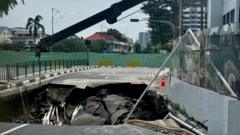When a sinkhole in Singapore swallowed a car, a group of seven migrant workers sprang into action, hoisting the female driver to safety with a rope. Their heroic efforts quickly captured attention on social media, prompting discussions on the rights and living conditions of the 1.17 million migrant workers in the city-state, predominantly from low-income countries like India, Bangladesh, and Myanmar.
Migrant workers are often employed in low-paid, labor-intensive jobs that local citizens tend to avoid. This incident has reopened conversations about their treatment, as many workers live in overcrowded dormitories and face exploitation by recruitment agencies and their employers, including severe underpayment and poor work conditions.
Previous actions by migrant workers, such as rescuing children from a house fire, underscore their critical role in society although they remain vulnerable to systemic exploitation. A social worker pointedly highlighted the irony of these workers, who often travel in the very trucks that endanger their lives, coming to the aid of a local citizen.
Despite past awareness campaigns, including highlighting dire living conditions during the Covid pandemic, not much has shifted. Discussions about changing transportation practices for workers have been ongoing, but substantial reforms have yet to materialize. Government officials maintain that banning the transport of workers in lorries would adversely affect local businesses, although this position has drawn criticism from human rights advocates.
Additionally, work permit holders, including those aiding in the sinkhole rescue, lack the opportunity to obtain permanent residency and face restrictions on marrying Singaporeans, further emphasizing their precarious status within the country.
Recently celebrated with commemorative coins for their bravery, some view the government’s acknowledgment as tokenism, arguing it fails to address the systemic issues they face daily. Activists campaign for concrete changes, including a living wage, enhanced workplace safety, and better healthcare access.
Meanwhile, a fundraising initiative, which accumulated significant support, illustrates a growing recognition of the humanitarian contributions made by migrant workers. Although communities are initiating activities to foster connections between migrant workers and residents, significant societal barriers remain, often reflected in public sentiment that perceives migrant workers as a separate, inferior class.
As the debate continues, the challenge remains for Singapore to acknowledge and address the rights of the workers that underpin its flourishing economy, ensuring that both their contributions and humanity are recognized beyond mere transactional encounters.


















